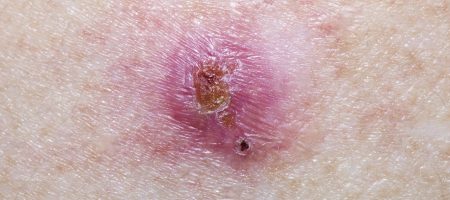Keratinocyte Cancers

Non-melanoma skin cancers, now called keratinocyte cancers, are the most common cancers in Australia, however most are not life-threatening.
There are two main types: basal cell carcinoma (BCC) and squamous cell carcinoma (SCC).
BCC accounts for about 70% of non-melanoma skin cancers. It begins in the lower layer of the epidermis (top, outer layer of the skin). It can appear anywhere on the body but most commonly develops on parts of the body that receive high or intermittent sun exposure (head, face, neck, shoulders and back).
SCC accounts for about 30% of non-melanoma skin cancers. It begins in the upper layer of the epidermis and usually appears where the skin has had most exposure to the sun (head, neck, hands, forearms and lower legs). SCC generally grows quickly over weeks or months.
A third group of lesions called keratinocyte dysplasias includes solar keratosis, Bowenoid keratosis and squamous cell carcinoma in-situ (Bowen’s disease or Intraepithelial carcinoma). These are not invasive cancers, however, may require treatment as some may develop into invasive skin cancers.
Symptoms
BCC often has no symptoms and tends to grow slowly without spreading to other parts of the body.
Symptoms of BCC can include:
- a pearly lump
- a scaly, dry area that is shiny and pale or bright pink in colour.
- a sore that does not heal or heals but then breaks down and bleeds again
Symptoms of SCC may include:
- thickened red, scaly spot
- rapidly growing lump
- looks like a sore that has not healed
- may be tender to touch.
Causes
Keratinocyte cancers occur when skin cells are damaged, for example, by overexposure to ultraviolet (UV) radiation from the sun. Between 95% and 99% of skin cancers in Australia are caused by exposure to the sun. The risk of skin cancer is increased for people who have:
- increased numbers of unusual moles (dysplastic naevi)
- fair skin, a tendency to burn rather than tan, freckles, light eye colour, light or red hair colour
- had a previous skin cancer
- people who are immune suppressed either as a result of medication (e.g. for solid organ transplant) or from a blood disorder or lymphoma.
Treatments
Keratinocyte cancer is treated in different ways. The treatment recommended by your doctors will depend on:
- the type, size and location of the cancer
- your general health
- any medicines you are taking (these may increase the risk of bleeding after surgery or delay healing)
- whether the cancer has spread to other parts of your body.
If the excision biopsy removed all the cancer, you may not need any further treatment.
Treatments options include:
- Surgery
- Curettage and electrodesiccation
- Cryotherapy
- Topical treatments (creams)
- Photodynamic therapy (cream and light treatment)
- Radiation therapy.
Resources
For further information, you can visit the following resources:

